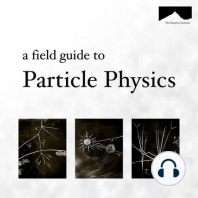3 min listen
The Z Boson
ratings:
Length:
3 minutes
Released:
Oct 7, 2021
Format:
Podcast episode
Description
The Field Guide to Particle Physics https://pasayten.org/the-field-guide-to-particle-physics©2021 The Pasayten Institute cc by-sa-4.0The definitive resource for all data in particle physics is the Particle Data Group: https://pdg.lbl.gov.The Pasayten Institute is on a mission to build and share physics knowledge, without barriers! Get in touch.The Z BosonEvery once in a while, without warning, an electron is accelerated seemingly out of nowhere. Ripped from whatever atom, molecule or metal it had been associated with, it suddenly becomes it’s own ballistic particle. When this happens, a Z-boson has almost certainly been involved.With a mass of 91.2 GeV, the Z boson is the slightly heavier cousin of the W-bosons. Together, W+, W- and Z0 all mediate the weak nuclear force. That is to say, particles with a weak charge toss them back and forth as a way to communicate that force. The W’s are famous for radioactive beta decay. The Z’s presence is more subtle. But all three are strictly left handed.Unlike the W’s, the Z boson has no electric charge. Like the photon, the Z boson is its own antiparticle. In many ways, the Z-boson is very similar to the photon. They share a common origin. They are quite literally mixed up with the Higgs boson.The Z’s don’t hang around very long. Being so heavy, they decay into all kinds of things: quarks, muons, neutrini, you name it! Like the W’s, they appear for something like 3×10^−25 seconds before decaying. A photon can’t even get across a proton that quickly.In principle, the proton and the electron should be able to communicate by sending both photons and Z-bosons. Although the Z-boson’s mass means that the strength of such interactions between particles dissipates quickly with distance, further diluting the already weak, weak nuclear force.That said, the Z can a have dramatic effect on everyday particles.Because the weak force is so weak, the humble neutrino almost never interacts with anything. This is probably good, because there are unfathomably many of them all around us, all the time. Given the sheer number of neutrini, it is a statistically inevitable that one will interact with something. A neutrino can push on an electron by the quick exchange of a Z-boson, a bit like throwing a bowling ball at an ice skater. Since we can’t otherwise see the neutrino, and the Z decays so quickly, from our perspective it will appear that the electron suddenly was accelerated, seemingly out of now here.
Released:
Oct 7, 2021
Format:
Podcast episode
Titles in the series (49)
The Tau: The tau is a very heavy species of elementary particle that aren’t quite as common as the electron or the muon. Nevertheless, just as the muon shares many of the properties with the electron, so too does the tau. by The Field Guide to Particle Physics
